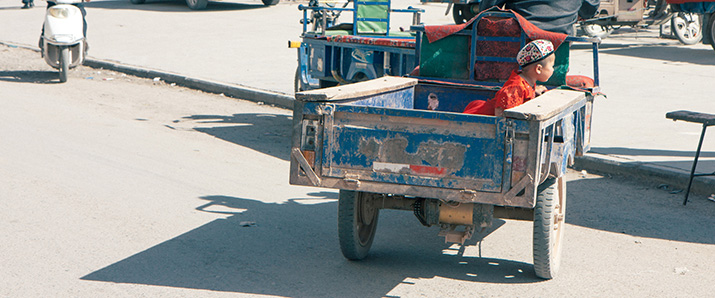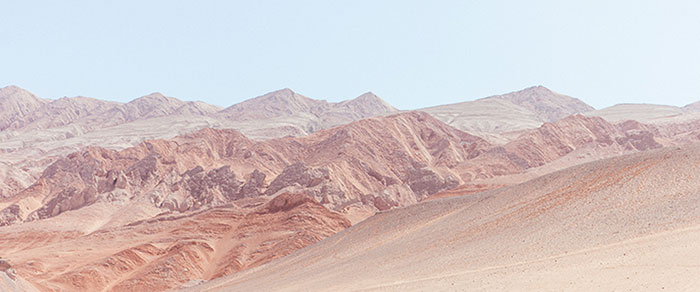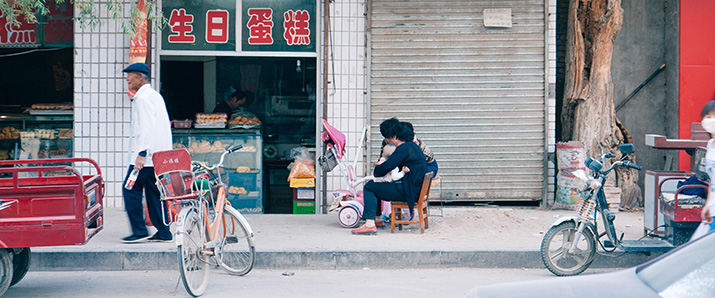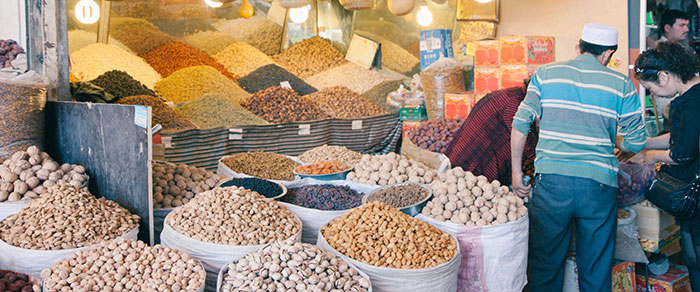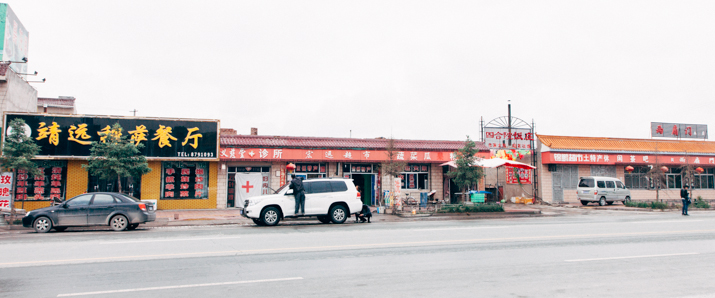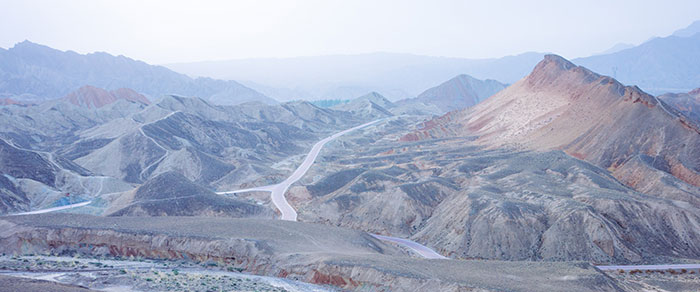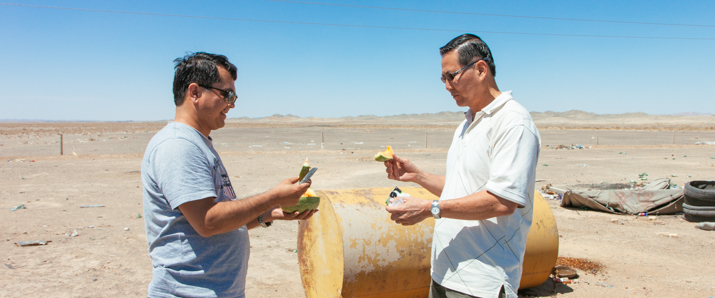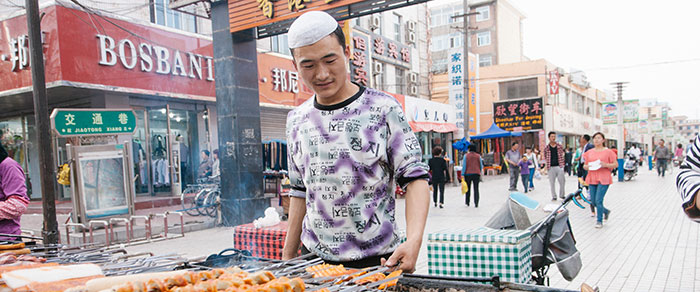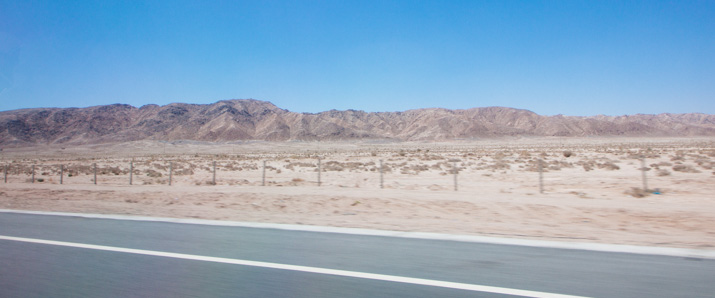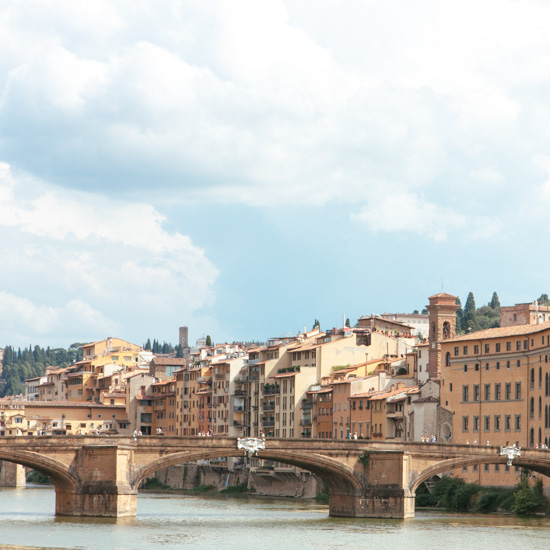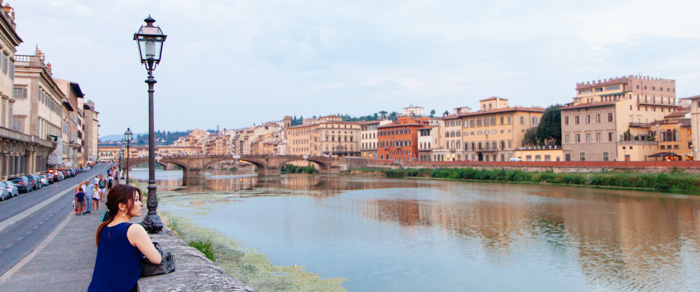First Encounter with Ablajan
He stood there reticently, scanning the crowd diligently for a stranger’s face. He had a placard with my name scrawled in large, childlike script, an unnecessary backup for we greeted each other with an offhand familiarity, after the torrent of email exchanges we had had. The only thing I could not have anticipated was his fluid American accent.
His Nissan Blue Bird, our little caravan over the next 10 days, was cared for with fatherly tenderness. Dust was constantly dabbed away with wet tissue, and the windscreen wiped to crystal clarity.
A wrinkled Winnie-the-Pooh pouch was attached to his dashboard, stuffed with small change for the many toll gates we would pass along the highway. A tiny device blinked with the push of a button, and immediately we would be on-grid in the cyber world.
An Authentic Uygur Meal
We strolled into a local Uygur restaurant for our very first meal, and peered at various body parts of lamb, all chopped up and ready to be kebab-ed and smoke grilled. Being a primarily desert region with bordering mountain ranges, mutton and wheat form the staple diet.
While some deep-fried fish can be found sold by street vendors, transported from lakes in neighbouring Russia, horse meat is a debatable subject. Most of the muslims in Xinjiang consider it an unclean animal, but the people in Yili do consume them.
Vegetarians are something of an enigma to them; Ablajan hears that it is a common phenomenon in India, and doubts he could survive there.
As an unspoken sign of respect, he always waited for the eldest at the table to begin eating, before starting on his own meal. He is also frugal with his orders, and finishes his food down to the last grain of rice, lest Allah not provide anymore.
A Short List of Uygur Foods
Kebabs
Ablajan selected a mixture of heart and liver kebabs, which came exotically and tastefully spiced; delicate cubes of meat alternated with fat, and melted in your mouth in a harmonious medley of cumin, chilli, salt and black pepper. You should rip these off the skewers with barbaric gusto using your teeth.
La Mian
He also ordered a portion of 拉面 (lā miàn), chewy hand-pulled wheat noodles which came finely chopped into macaroni-sized bits, colourfully speckled with red tomatoes, green peppers, earthen mutton or beef, and pale onions.
Polo
Another staple of the Uygur people is polo (pilaf or plov) – rice mixed with bits of vegetables and of course, mutton, drenched in sunflower oil. There is something addictive about oily carbohydrates, and this comes with a bowl of yoghurt to digest with.
Naan
A small basket of Uygur style naan bread sat at the corner of the table. It is drier and flatter than the Indian version, and came sprinkled generously with sesame seeds.
Black Tea
Coffee is a rarity in Xinjiang, but weak black tea can be found in endless supply on any dining table. Alcohol is forbidden in Islam, and Ablajan was despaired to spot a group of Uygurs consuming bottles of beer on the streets of Turpan.
Xinjiang Regional Museum
We headed to the museum close by, where I wanted to observe some mysterious mummies of European descent. Sharp of feature with spindly fingers of unnatural length, they were dressed in mottled furs, patterned in well-preserved dyes.
They looked like sleeping mannequins that were never animated with life, softening the barrier between death as proved by the hordes of Chinese tourists casually tapping their glass caskets, and snapping pictures with bright flashlights from all angles possible.
There was also an entire floor dedicated to emulating the different minority groups in their living environments. Without understanding all the intricacies, the art, costumes and physical features of the Khalkhas, Kazakhs and Tartars captivated me the most.
These mannequins displayed an elegance which enchanted me – how do these people possess so much grace while living in such rural landscapes? Their decorative motifs and colour palettes also seemed a little more refined – floral or patterned designs composed selectively against a dark background; less of the dizzy, neon geometry I usually associate with Asian tribal art.
The rest of the museum was filled with minor artifacts, and models of other parts of Xinjiang – tiny environs which we would step into for real over the next few days.
Erdaoqiao Market
The air was characteristic of the desert region, arid and still. Uygur merchants donned in embroidered doppa hats sit placidly by their stores, trailing passersby with a lazy eye.
Slabs of richly churned ice cream bake under the sun, but do not melt. A woman grips the handle of her ladle, waiting for an order of plain sheep’s yoghurt.
Pomegranates from the last season in October have been juiced and divided into ornamental glasses, plated with flaking gold. It still tastes of pure goodness.
Dim entrances beckon you into sheltered bazaars, teeming with endless rows of Central Asian spices, nuts and dried fruit. Pistachios, cashews, and plenty of raisins are traded from further west, sold here for cheap by the kilogram.
Tourist knick-knack stores are copies of the last, selling wonderfully useless things. Crudely carved hand mirrors plated with silver, hefty bangles crusted with semi-precious stones, ornate hair clips shaped into butter and dragonflies. Somehow the intended audience seems to be female; knowing that didn’t stop me from purchasing a few choice pieces.
Interesting Reads:
1. On the Karakoram Highway to Khunjerab Pass in Xinjiang (Shanghai Street Stories) – http://qr.net/mT2q
2. Uighur Lamb Kebabs (Globetrotter Diaries) – http://qr.net/ksT3
3. Food from Xinjiang (Sapore di Cina) – http://qr.net/mTZG
4. Photography (China in Central Asia) – http://qr.net/mT6c
5. The Tale of the Freedom Goddess and Other Adventures in School (This is Xinjiang blog) – http://qr.net/mT60
6. Travel Xinjiang and the Silk Road (Far West China) – http://www.farwestchina.com/
More from china
Writing
A Thousand Years in the Mogao Grottoes: #4
Photography
The Rich Silk Route History of Turpan: Part 1
Writing
An Observation on Chinese Culture: Part 2
Photography
Springtime in Kashgar
Writing
The Passage to Lanzhou: #2
Photography
A Surrealism Fit for Martians
Writing
A Thousand Years in the Mogao Grottoes: #5
Photography
Zhangye, the Everyday Marco Polo Town
Writing
A Thousand Years in the Mogao Grottoes: #2
